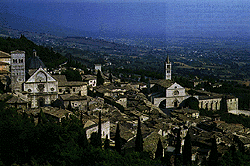 Located in the Umbrian region which is known as the mystical heart of Italy, Assisi is a well preserved medieval city built upon the sides of a small mountain. Smollet wrote as he traveled through Italy; "On the right-hand, we saw several towns situated on rising grounds, and among the rest, that of Assisio, famous for the birth of St. Francis" (Smollet 283). Indeed, the fame of Assisi is that it was the birthplace of Italy's patron saint, St. Francis, who was a 12th century monk whose beliefs and teachings generated a revolution within the Catholic church and led to the formation of the Franciscan order of monks (Young 176). St. Francis spent much of his time preaching and wandering through Spain and Morocco, and with the Crusaders to Egypt and the Holy Land (Facaros and Pauls 786). St. Francis' motto that was instituted by Honorius III and that is practiced and supported by the Franciscan Order is poverty, chastity, and obedience. The story of St. Francis is particularly interesting because he was the son of a wealthy merchant, and he gave up the pleasures of his home and his own military ambitions to devote himself to a service to the poor and sick (Baedeker's 67). The Basilica de San Francisco in Assisi is the home of the Franciscan order, contains the tomb of St. Francis, and is the main attraction of Assisi. In the nave of the church there are 28 scenes painted by Giotto and his pupils that represent the life of St. Francis, and the basilica is lightly colored and well lighted inside so that you can see what remains of the frescoes. The upper part of the church pays tribute to St. Francis' sainthood and consecration, and this two-fold church design became an architectural style known not surprisingly as Franciscan (Young 178). Along the main street, the Via San Francesco, is a spot that used to be the site of a Roman forum and the Augustan church known as the Temple of Minerva is still standing there. Also located around the town are churches on important sites, such as the place that St. Francis was born and the place where St. Francis' disciple, St. Clare, is buried. High above the town is the castle of Rocca Maggiore where Frederick II is said to have spent some time in his youth, and which offers a dramatic view over Assisi and the Umbrian countryside (Young 179). The streets of Assisi are narrow, steep, and cobblestoned and the town has the flavor and feeling of that Medieval time in which it was mostly built. There are two times during the year that Assisi becomes festive: during Easter week and during "Calendimaggio" which is a Medieval May Day celebration in memory of St. Francis (Facaros and Pauls 787).
Located in the Umbrian region which is known as the mystical heart of Italy, Assisi is a well preserved medieval city built upon the sides of a small mountain. Smollet wrote as he traveled through Italy; "On the right-hand, we saw several towns situated on rising grounds, and among the rest, that of Assisio, famous for the birth of St. Francis" (Smollet 283). Indeed, the fame of Assisi is that it was the birthplace of Italy's patron saint, St. Francis, who was a 12th century monk whose beliefs and teachings generated a revolution within the Catholic church and led to the formation of the Franciscan order of monks (Young 176). St. Francis spent much of his time preaching and wandering through Spain and Morocco, and with the Crusaders to Egypt and the Holy Land (Facaros and Pauls 786). St. Francis' motto that was instituted by Honorius III and that is practiced and supported by the Franciscan Order is poverty, chastity, and obedience. The story of St. Francis is particularly interesting because he was the son of a wealthy merchant, and he gave up the pleasures of his home and his own military ambitions to devote himself to a service to the poor and sick (Baedeker's 67). The Basilica de San Francisco in Assisi is the home of the Franciscan order, contains the tomb of St. Francis, and is the main attraction of Assisi. In the nave of the church there are 28 scenes painted by Giotto and his pupils that represent the life of St. Francis, and the basilica is lightly colored and well lighted inside so that you can see what remains of the frescoes. The upper part of the church pays tribute to St. Francis' sainthood and consecration, and this two-fold church design became an architectural style known not surprisingly as Franciscan (Young 178). Along the main street, the Via San Francesco, is a spot that used to be the site of a Roman forum and the Augustan church known as the Temple of Minerva is still standing there. Also located around the town are churches on important sites, such as the place that St. Francis was born and the place where St. Francis' disciple, St. Clare, is buried. High above the town is the castle of Rocca Maggiore where Frederick II is said to have spent some time in his youth, and which offers a dramatic view over Assisi and the Umbrian countryside (Young 179). The streets of Assisi are narrow, steep, and cobblestoned and the town has the flavor and feeling of that Medieval time in which it was mostly built. There are two times during the year that Assisi becomes festive: during Easter week and during "Calendimaggio" which is a Medieval May Day celebration in memory of St. Francis (Facaros and Pauls 787).